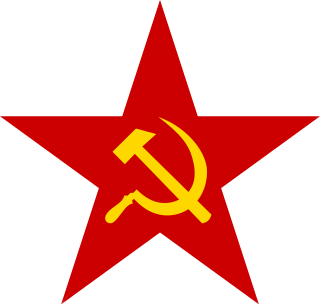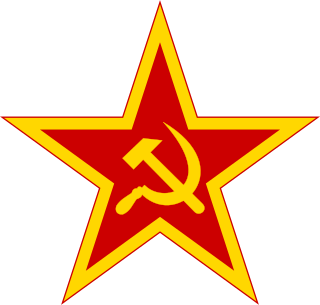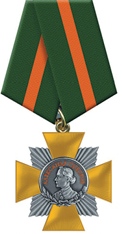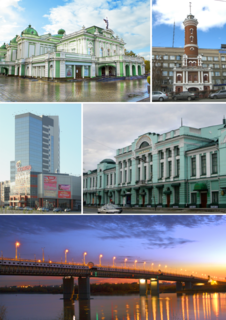| 29th Rifle Division | |
|---|---|
| Active |
|
| Country | |
| Branch | |
| Type | Division |
| Role | Infantry |
| Engagements | |
| Decorations | |
| Honorifics | |
The 29th Rifle Division was an infantry division of the Red Army and later the Soviet Army.

The Workers' and Peasants' Red Army, frequently shortened to Red Army was the army and the air force of the Russian Soviet Federative Socialist Republic, and, after 1922, the Union of Soviet Socialist Republics. The army was established immediately after the 1917 October Revolution. The Bolsheviks raised an army to oppose the military confederations of their adversaries during the Russian Civil War. Beginning in February 1946, the Red Army, along with the Soviet Navy, embodied the main component of the Soviet Armed Forces; taking the official name of "Soviet Army", until its dissolution in December 1991.

The Soviet Army is the name given to the main land-based branch of the Soviet Armed Forces between February 1946 and December 1991, when it was replaced with the Russian Ground Forces, although it was not fully abolished until 25 December 1993. Until 25 February 1946, it was known as the Red Army, established by decree on 15 (28) January 1918 "to protect the population, territorial integrity and civil liberties in the territory of the Soviet state." The Strategic Missile Troops, Air Defense Forces and Air Forces were part of the Soviet Army in addition to the Ground Forces.
Contents
It was first formed in November 1920 from the 1st Siberian Rifle Division, and fought in the Russian Civil War in Siberia. It was relocated to Belarus in 1923 and became a territorial division during the interwar period. In 1939 it fought in the Soviet invasion of Poland and was converted into a motorised division in July 1940. As part of the 6th Mechanized Corps, the division was destroyed in Operation Barbarossa, the German invasion of the Soviet Union, in late June 1941. The 29th was reformed from the 7th Moscow People's Militia Division in July, but destroyed in the Battle of Vyazma in October. A third 29th was formed in Kazakhstan in December and converted to the 72nd Guards Rifle Division for its actions in the Battle of Stalingrad in the spring of 1943.

The Russian Civil War was a multi-party war in the former Russian Empire immediately after the two Russian Revolutions of 1917, as many factions vied to determine Russia's political future. The two largest combatant groups were the Red Army, fighting for the Bolshevik form of socialism led by Vladimir Lenin, and the loosely allied forces known as the White Army, which included diverse interests favoring political monarchism, economic capitalism and alternative forms of socialism, each with democratic and antidemocratic variants. In addition, rival militant socialists and nonideological Green armies fought against both the Bolsheviks and the Whites. Eight foreign nations intervened against the Red Army, notably the former Allied military forces from the World War and the pro-German armies. The Red Army eventually defeated the White Armed Forces of South Russia in Ukraine and the army led by Admiral Aleksandr Kolchak to the east in Siberia in 1919. The remains of the White forces commanded by Pyotr Nikolayevich Wrangel were beaten in Crimea and evacuated in late 1920. Lesser battles of the war continued on the periphery for two more years, and minor skirmishes with the remnants of the White forces in the Far East continued well into 1923. The war ended in 1923 in the sense that Bolshevik communist control of the newly formed Soviet Union was now assured, although armed national resistance in Central Asia was not completely crushed until 1934. There were an estimated 7,000,000–12,000,000 casualties during the war, mostly civilians. The Russian Civil War has been described by some as the greatest national catastrophe that Europe had yet seen.

In the context of the history of the 20th century, the interwar period was the period between the end of the First World War in November 1918 and the beginning of the Second World War in September 1939.

The Soviet invasion of Poland was a military operation by the Soviet Union without a formal declaration of war. On 17 September 1939, the Soviet Union invaded Poland from the east, sixteen days after Germany invaded Poland from the west. Subsequent military operations lasted for the following 20 days and ended on 6 October 1939 with the two-way division and annexation of the entire territory of the Second Polish Republic by Germany and the Soviet Union. The Soviet invasion of Poland was secretly approved by Germany following the signing of the Molotov–Ribbentrop Pact on 23 August 1939.
The 29th was reformed for a fourth time in 1943. It served through the rest of the war and was awarded the honorific Polotsk and the Order of Suvorov. Postwar, it was withdrawn to the Volga Military District and reduced to a brigade, which became the 63rd Mechanised Division in 1953. In 1957 it became the 110th Motor Rifle Division before being renumbered as the 29th in 1964. It relocated to Kamen-Rybolov in 1968, serving there until its disbandment after the end of the Cold War.

Polotsk is a historical city in Belarus, situated on the Dvina River. It is the center of the Polotsk District in Vitsebsk Voblast. Its population is more than 80,000 people. It is served by Polotsk Airport and during the Cold War was home to Borovitsy air base.

The Order of Suvorov is a military decoration of the Russian Federation named in honor of Russian Field Marshal Count Alexander Suvorov (1729–1800).
The Volga Military District (PriVO) was a military district of the Soviet Union and the Russian Federation that existed from 1918 to 1989 and 1992 to 2001.




